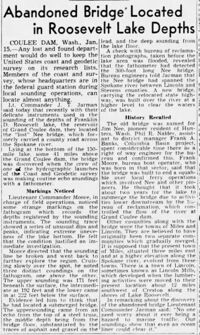1949-01-15-sc-p23-nee-bridge-rediscovered-and-recounted
January 15, 1949 Spokane Daily Chronicle Page 23:
'Abandoned Bridge Located in Roosevelt Lake Depths
COULEE DAM, Wash., Jan. 15--Any lost and found department would do well to keep the United States coast and geodetic survey on its research lists. Members of the coast and survey, whose headquarters are in the federal guard station during local sounding operations, can locate almost anything.
Lt. Commander J. T. Jarman said today that recently with their delicate instruments used in the sounding of the depths of Franklin D. Roosevelt lake, the reservoir of Grand Coulee dam, they located the “lost” Nee bridge, which for formerly carried a county road across the Spokane River.
Lying at the bottom of the 150-mile lake, some 41 miles above the Grand Coulee dam, the bridge was discovered when the crew of one of the hydrographic launches of the Coast and Geodetic survey was making routine echo soundings with a fathometer.
Markings Noticed
Lieutenant Commander Moore, in charge of field operations, noticed some strange markings on the fathogram which records the depths registered by the sounding instruments. The sounding trace showed a series of unusual dips and peaks, indicating extreme uneveness of the lake bottom. He felt that the condition justified an immediate investigation.
Moore directed that the sounding line be broken and went back to further explore the region. Cruising slowly over the spot, he noted three distinct soundings on the fathogram, one above the other. The upper sounding was 171 feet beneath the surface, the intermediate at 192 feet and the lower came in at 222 feet below the surface.
Evidence led him to think that he had located a submerged bridge. The upper sounding came from an echo from the top of a steel truss, the middle depth being from the bridge floor, substantiated by the traces of asphalt and gravel on the lead, and the deep sounding from the lake floor.
A check with bureau of reclamation photographs, taken before the lake area was flooded, revealed that the fathometer had detected the 300-foot long Nee bridge. Bureau engineers told Jarman that the Nee bridge had spanned the Spokane river between Lincoln and Stevens counties. A new bridge carrying the relocated state highway, was built over the river at a higher level to clear the waters of the lake.
History Recalled
The old bridge was named for Jim Nee, pioneer resident of Hunters, Wash. Phil R. Nalder, assistant to district manager Frank A. Banks, Columbia Basin project, Spent considerable time there as a right of way engineer for the bureau and confirmed this. Frank Moore, bureau boat operator, who was born in that sector, said that the bridge was built to end a squabble over local ferry operations which involved Nee and other pioneers, He thought that it took about two years for the lake to submerge the bridge due to activities lower downstream by the bureau of reclamation, which controlled the flow of the river at Grand Coulee dam.
Other casualties along with bridge were the towns of Miles and Lincoln. They are believed to have originally been two separate communities which gradually merged. It is supposed that the present town of Miles, situated three miles east and at a higher elevation along the Spokane river, evolved from these towns. There is a town of Lincoln, sometimes known as Lincoln Mills, which developed when the lumbering activities were moved to their present location about 12 miles southwest of Creston along the shores of Lake Roosevelt.
In remarking about the discovery of the abandoned bridge Lieutenant Commander Jarman said: “No one need worry about it ever being a hazard to marine traffic. Our soundings show that even an ocean liner could clear it.”
